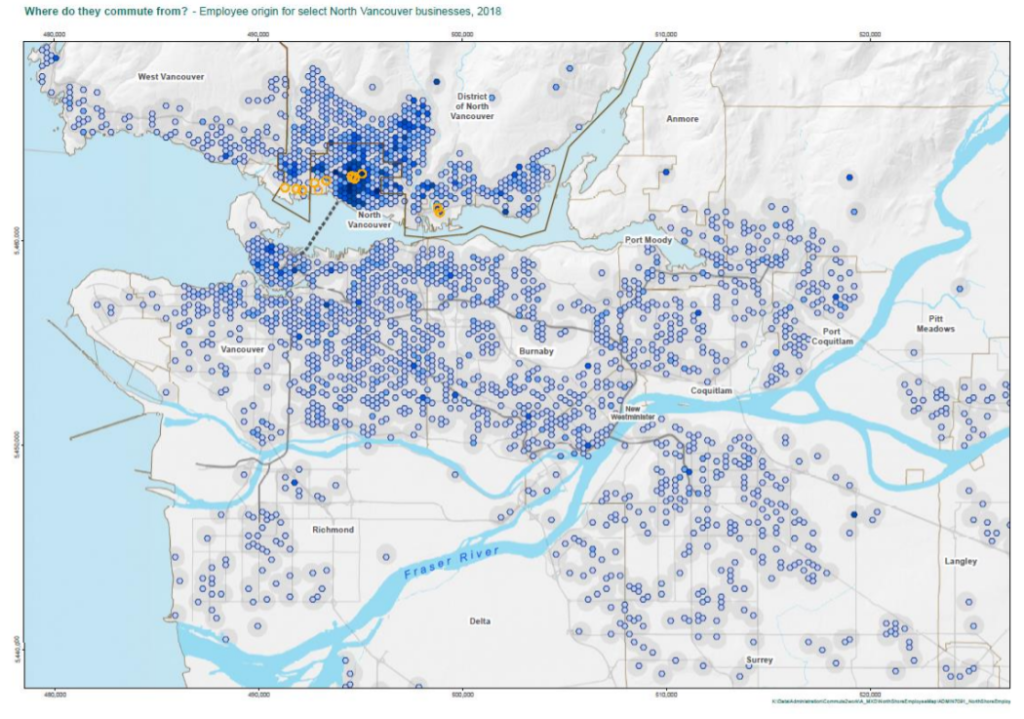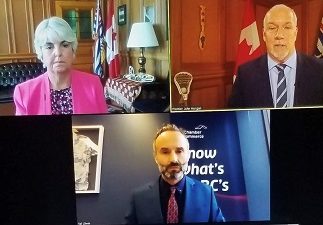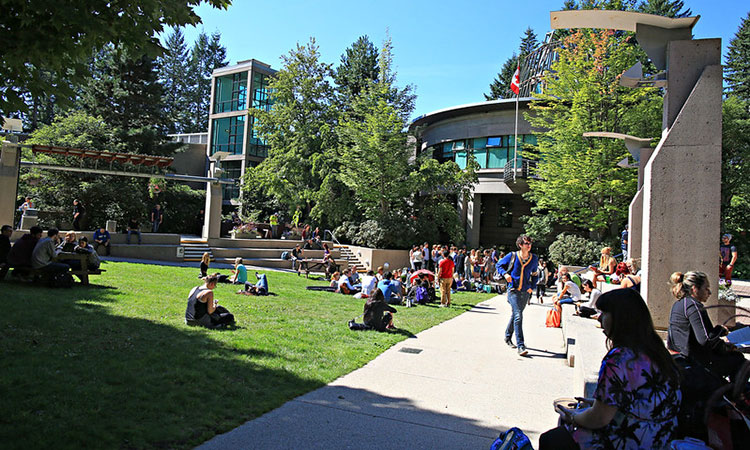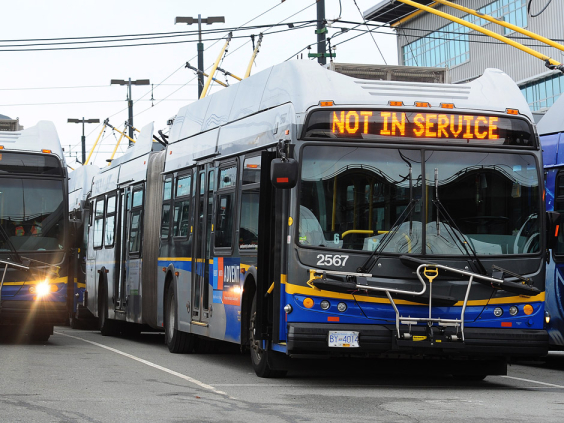Transportation Connecting the North Shore and Metro Vancouver: Quantifying the Economic Impact and Defining the Solutions
Introduction
Efficiently moving people and goods is essential for economic growth and for building healthy communities. The economy and employment of the North Shore, the Sea to Sky and Sunshine Coast communities are inextricably linked to that of Metro Vancouver. However, the current transportation infrastructure connecting the North Shore to the rest of Metro Vancouver is inadequate and is stifling the economic sustainability of the port, of industry, of tourism and the viability of business in the entire region.
A comprehensive study is required to define the economic impacts of the existing transportation infrastructure deficit on competitiveness, productivity and economic growth in the region, and to define and evaluate specific transportation technologies and routes linking the North Shore to Metro Vancouver which will bring the greatest economic benefit to the region.
Background
The number one issue for North Vancouver business is transportation.Traffic congestion on the North Shore is a well-known problem to businesses, residents and elected officials. Through extensive business and community consultation, the NV Chamber has confirmed that this is the number one economic issue here, and that it is significantly impacting current business operations including long-term investment decision-making on the North Shore and the entire Sea to Sky economy. The traffic congestion creates significant barriers and delays for employees getting to work from other metro Vancouver municipalities and for the significant goods movement on the North Shore.
The North Vancouver Chamber (including Economic Partnership North Vancouver) has conducted extensive consultation in the development of support for this initiative. The opinions represented here are directly supported at the CEO/owner/executive-level by businesses that provide approximately 2/3 of all employment in North Vancouver. It also includes consultation and support from the Chambers in West Vancouver, Squamish, Whistler and Pemberton. These include major regional sector leaders and employers such as:
- Seaspan
- Arc’teryx
- Neptune Terminals
- BlueShore Financial
- North Shore Studios
- Capilano Suspension Bridge
- Port of Vancouver
- Vancouver Coastal Health
- Western Stevedoring
- Capilano University
- North Shore Auto Mall
- Hatfield Consultant
- District of North Vancouver
- City of North Vancouver
- Business Development Bank of Canada
- Darwin Properties
- Quay Property Management
- Squamish Nation
- Tsleil-Waututh Nation
Our significant consultation to date includes the following:
- “Economy in Gridlock” transportation forum (November 2017) with panelists CEO TransLink, CEO Seaspan, VP Arc’teryx, SFU Professor.
- Business Survey Results (December 2017)
- 84% said transportation negatively affects their ability to attract employees;
- 95% said traffic negatively affects their ability to move to and from North Vancouver.
- Transportation Summit (January 2018) to present results from our transportation survey to:
- Mayors from City of North Vancouver, District of North Vancouver, West Vancouver;
- MLAs from the North Shore and Sea to Sky ridings;
- MP from North Vancouver (Jonathan Wilkinson);
- TransLink CEO, Kevin Desmond.
Local, regional and national economies depend on reliable access to and from the North Shore.
Local economy: The North Shore has a truly diverse economy that employs and attracts people on a daily basis from across Metro Vancouver. It boasts:
- A thriving port, a large healthcare sector, a successful film industry, an innovative tech and manufacturing sector, and a large base of entrepreneurial, home-based businesses;
- Two of the top three tourist attractions in BC, drawing 2.5 million visitors annually1
- Capilano University, which enrolls over 11,600 students annually2
- Seaspan, the largest manufacturer in Metro Vancouver, with 2,650 employees3
The following heat map illustrates where employees travel from when commuting to North Vancouver:

Economy – Corridor to Sea to Sky/Sunshine Coast: The North Shore plays a vital role in traveller and visitor access to BC’s recreation and tourism communities:
- The North Shore is the link to Whistler, consistently rated as a world class, year-round destination community, attracting over 2.5 million unique visitors and generating nearly $1.3 billion in consumer spending per year. This represents 22% of BC’s provincial export tourism economy4
- Reliable transportation options are critical for Whistler, Squamish and other growing economies on the Sea to Sky corridor, the Sunshine Coast and Vancouver Island.
Economy – Federal Port: The North Shore is strategically located and serves Canada as one of
the largest multi-commodity ports in the world:
- The movement of goods and commodities through North Vancouver from BC and other provinces plays a prominent role in regional and international trade, with the Port of Vancouver handling nearly 136 million tonnes of cargo in 2016. This cargo throughput is valued at $202 billion, which equates to approximately 19% of Canada’s total foreign trade5
We know we need an investment in transportation infrastructure. The first step is quantifying the problem and defining the solution.
Transportation infrastructure requires significant investment. Construction costs for urban rail projects around the world vary widely, from $40 million to $4 billion per kilometre7,8 depending on a number of variables.9 One option, fixed-link rapid transit to the North Shore, would likely have a similar order of magnitude to the 6-kilometre long Millennium Line Broadway Extension, which is estimated to be $1.98 billion, or $330 million per kilometre.10
Transportation infrastructure is one of the pillars of competitiveness that determine how productive and prosperous a region, and country, is.11 Today congestion takes a major toll on our productivity by slowing the movement of goods and people. The visible costs of congestion in Metro Vancouver – excess vehicle crashes and wasted time in traffic – are estimated to be $500 million per year. This figure does not include wider economic costs, such as workers who don’t take jobs best fit for them, businesses who draw from a shallower pool of workers than they would otherwise, and companies with unique offerings that do not have ready access to a broad market.12
To understand the true economic cost-benefit of transportation infrastructure investment linking the North Shore to Metro Vancouver, we need to quantify the economic impact of the existing transportation infrastructure deficit on competitiveness, productivity and economic growth, along with the costs of specific solutions.
The BC government has recognized the need for better coordination on transportation planning.
The North Shore Integrated Transportation Planning Project led by North Vancouver Lonsdale MLA Bowinn Ma, Parliamentary Secretary for TransLink, is an initiative is underway to address the transportation problem on the North Shore. It is a step in the right direction, but its recommendations for prioritization of investment and the timeframe for action are unclear.
THE CHAMBER RECOMMENDS
- That the provincial government expeditiously invest in a study to:
- Quantify the economic impacts of the existing transportation infrastructure deficit on competitiveness, productivity and economic growth for the North Shore, Sea to Sky and Sunshine Coast communities, and;
- Define and evaluate specific transportation technologies and routes linking the North Shore and Metro Vancouver, including a fixed-link rapid transit connection, in order to determine the appropriate solutions with the greatest economic benefit to the region.
- That the provincial government prioritize regional business and economic benefits in transportation infrastructure investments
Submitted by the North Vancouver Chamber of Commerce
Supported by:
- West Vancouver Chamber of Commerce
- Squamish Chamber of Commerce
- Whistler Chamber of Commerce
- Pemberton & District Chamber of Commerce
1Business in Vancouver, https://biv.com/datatables/biggest-tourist-attractions-bc-2018
2Capilano University, https://www.capilanou.ca/about/
3 Business in Vancouver, https://biv.com/datatables/top-100-biggest-manufacturers-metro-vancouver-2018
4Trade and Invest British Columbia, https://www.britishcolumbia.ca/invest/communities/british-columbia/lower-mainlandsouthwest/squamish-lillooet/whistler/
5Port of Vancouver 2016 Economic Impact Study, https://www.portvancouver.com/wp-content/uploads/2016/05/2016-Port-of-VancouverEconomic-Impact-Study.pdf
7US Rail Construction Costs, Pedestrian Observations, 2011, https://pedestrianobservations.com/2011/05/16/us-rail-construction-costs/
8The Costs of Tunneling, Greater Auckland, 2016, https://www.greaterauckland.org.nz/2016/10/05/the-costs-of-tunnelling/
9Comparison of Capital Costs per Route-Kilometre in Urban Rail, European Journal of Transport and Infrastructure Research, Aalborg University, 2008, http://vbn.aau.dk/files/14076659/Comparison_of_Capital_Costs.pdf
10Regional Transportation Investment: A Vision for Metro Vancouver, Mayors’ Council on Regional Transportation, https://tenyearvision.translink.ca/downloads/10%20Year%20Vision%20for%20Metro%20Vancouver%20Transit%20and%20Transportation.pdf
11The Global Competitiveness Report 2014-2015, World Economic Forum, http://www3.weforum.org/docs/WEF_GlobalCompetitivenessReport_2014-15.pdf
12Tackling Traffic: The Economic Cost of Congestion in Metro Vancouver, CD Howe Institute, March 9, 2015, http://cleanenergycanada.org/wpcontent/uploads/2015/03/TacklingTrafficCDHoweInstitute.pdf



